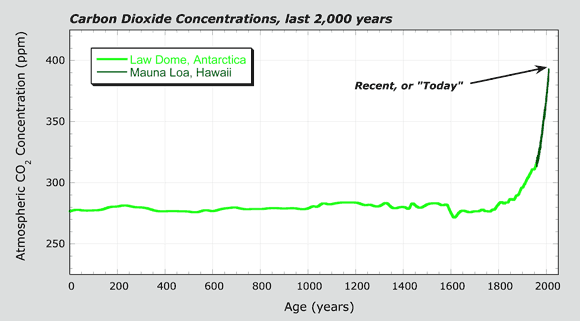Unit 2: Carbon Now
2: Overview
Introduction
You did a lot in Unit 1 of Carbon Connections. In that unit, you considered the movement of carbon among different parts of Earth and over many thousands of years. Carbon is stored in land, atmosphere, and oceans.
One indicator of past climate is carbon as CO2 in the atmosphere. When CO2 levels were high, average temperatures for Earth were high. When CO2 levels were low, average temperatures for Earth were low. The main concepts from Unit 1 were:
- The climate of Earth is connected to the carbon cycle.
- A number of indicators tell of past climates for Earth.
- Forcings lead to a response, and sometimes the response has a time lag.
- The molecule CO2 is an important greenhouse gas, as well as a key part of the carbon cycle.
- Models and simulations help you to understand systems and physical processes on Earth.


At the end of Unit 1, you saw graphs that showed the recent increase in atmospheric CO2. The levels were greater than anything in the ice core record. Scientists are studying this large, recent increase in atmospheric CO2. More CO2 in the atmosphere causes an increase in the planet's temperature. But a question remains: "By how much could temperatures increase?" You will explore that later.


But first, in Unit 2, you will investigate carbon in the present. To better understand climate, it helps to investigate in more detail some of the processes that move carbon around Earth. For example, you have heard of photosynthesis and respiration. You will learn more about these vital natural processes that transfer carbon in the Earth system. Another key player in the carbon cycle and climate are humans. Humans using fossil fuels for energy adds CO2 to the atmosphere.
Maybe you have heard people say that one way to counteract increasing CO2 in the atmosphere is to plant trees. That will only help if the carbon stays with the wood in the tree. You will investigate issues like these in this unit. The lessons for this unit are in the Unit 2 Organizer. The main concepts you'll learn are:
- Processes—such as photosynthesis and respiration—transfer carbon among the parts of the Earth system.
- Humans use a variety of technologies to monitor carbon moving in the Earth system.
- Models and simulations help you better understand the systems and physical processes that are active on Earth.
- Fossil fuels are a key part of generating electrical energy for use by humans, but this also leads to increasing CO2 levels in the atmosphere.